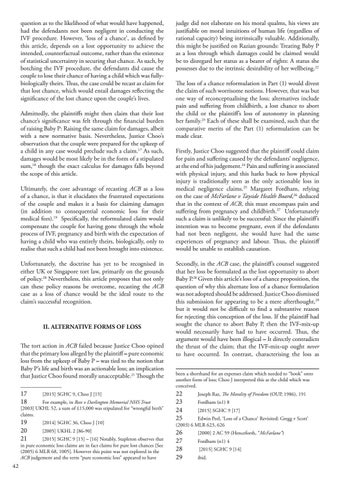question as to the likelihood of what would have happened, had the defendants not been negligent in conducting the IVF procedure. However, ‘loss of a chance’, as defined by this article, depends on a lost opportunity to achieve the intended, counterfactual outcome, rather than the existence of statistical uncertainty in securing that chance. As such, by botching the IVF procedure, the defendants did cause the couple to lose their chance of having a child which was fullybiologically theirs. Thus, the case could be recast as claim for that lost chance, which would entail damages reflecting the significance of the lost chance upon the couple’s lives. Admittedly, the plaintiffs might then claim that their lost chance’s significance was felt through the financial burden of raising Baby P: Raising the same claim for damages, albeit with a new normative basis. Nevertheless, Justice Choo’s observation that the couple were prepared for the upkeep of a child in any case would preclude such a claim.17 As such, damages would be most likely be in the form of a stipulated sum,18 though the exact calculus for damages falls beyond the scope of this article. Ultimately, the core advantage of recasting ACB as a loss of a chance, is that it elucidates the frustrated expectations of the couple and makes it a basis for claiming damages (in addition to consequential economic loss for their medical fees).19 Specifically, the reformulated claim would compensate the couple for having gone through the whole process of IVF, pregnancy and birth with the expectation of having a child who was entirely theirs, biologically, only to realise that such a child had not been brought into existence. Unfortunately, the doctrine has yet to be recognised in either UK or Singapore tort law, primarily on the grounds of policy.20 Nevertheless, this article proposes that not only can these policy reasons be overcome, recasting the ACB case as a loss of chance would be the ideal route to the claim’s successful recognition.
II. ALTERNATIVE FORMS OF LOSS The tort action in ACB failed because Justice Choo opined that the primary loss alleged by the plaintiff – pure economic loss from the upkeep of Baby P – was tied to the notion that Baby P’s life and birth was an actionable loss; an implication that Justice Choo found morally unacceptable.21 Though the
17 18
[2015] SGHC 9, Choo J [15]
For example, in Rees v Darlington Memorial NHS Trust [2003] UKHL 52, a sum of £15,000 was stipulated for “wrongful birth” claims.
19 20 21
[2014] SGHC 36, Choo J [10] [2005] UKHL 2 [86-90]
[2015] SGHC 9 [15] – [16] Notably, Stapleton observes that in pure economic loss claims are in fact claims for pure lost chances [See (2005) 6 MLR 68, 1005]. However this point was not explored in the ACB judgement and the term “pure economic loss” appeared to have
42
judge did not elaborate on his moral qualms, his views are justifiable on moral intuitions of human life (regardless of rational capacity) being intrinsically valuable. Additionally, this might be justified on Razian grounds: Treating Baby P as a loss through which damages could be claimed would be to disregard her status as a bearer of rights: A status she possesses due to the intrinsic desirability of her wellbeing.22 The loss of a chance reformulation in Part (1) would divest the claim of such worrisome notions. However, that was but one way of reconceptualising the loss; alternatives include pain and suffering from childbirth, a lost chance to abort the child or the plaintiff’s loss of autonomy in planning her family.23 Each of these shall be examined, such that the comparative merits of the Part (1) reformulation can be made clear. Firstly, Justice Choo suggested that the plaintiff could claim for pain and suffering caused by the defendants’ negligence, at the end of his judgement.24 Pain and suffering is associated with physical injury, and this harks back to how physical injury is traditionally seen as the only actionable loss in medical negligence claims.25 Margaret Fordham, relying on the case of McFarlane v Tayside Health Board,26 deduced that in the context of ACB, this must encompass pain and suffering from pregnancy and childbirth.27 Unfortunately such a claim is unlikely to be successful: Since the plaintiff’s intention was to become pregnant, even if the defendants had not been negligent, she would have had the same experiences of pregnancy and labour. Thus, the plaintiff would be unable to establish causation. Secondly, in the ACB case, the plaintiff’s counsel suggested that her loss be formulated as the lost opportunity to abort Baby P.28 Given this article’s loss of a chance proposition, the question of why this alternate loss of a chance formulation was not adopted should be addressed. Justice Choo dismissed this submission for appearing to be a mere afterthought,29 but it would not be difficult to find a substantive reason for rejecting this conception of the loss. If the plaintiff had sought the chance to abort Baby P, then the IVF-mix-up would necessarily have had to have occurred. Thus, the argument would have been illogical – It directly contradicts the thrust of the claim; that the IVF-mix-up ought never to have occurred. In contrast, characterising the loss as been a shorthand for an expenses claim which needed to “hook” onto another form of loss; Choo J interpreted this as the child which was conceived.
22 23 24 25
Joseph Raz, The Morality of Freedom (OUP, 1986), 191
26 27 28 29
[2000] 2 AC 59 (Henceforth, “McFarlane”)
Fordham (n1) 8 [2015] SGHC 9 [17]
Edwin Peel, ‘Loss of a Chance’ Revisited: Gregg v Scott’ (2003) 6 MLR 623, 626 Fordham (n1) 4 [2015] SGHC 9 [14] ibid.
